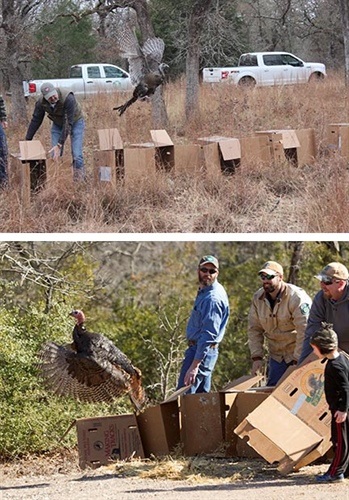 A turkey trap-and-release effort originating in North Carolina is helping boost wild turkey populations in Texas. The effort, a joint venture involving the N.C. Wildlife Resources Commission, Texas Parks and Wildlife Department<https://tpwd.texas.gov/>, USDA APHIS Wildlife Services<https://www.aphis.usda.gov/aphis/home/> and the National Wild Turkey Federation<http://www.nwtf.org/> (NWTF), began in December and will finish up this month, with an anticipated several dozen eastern wild turkeys making their way from airstrips in eastern and central North Carolina to restoration sites in east Texas.
A turkey trap-and-release effort originating in North Carolina is helping boost wild turkey populations in Texas. The effort, a joint venture involving the N.C. Wildlife Resources Commission, Texas Parks and Wildlife Department<https://tpwd.texas.gov/>, USDA APHIS Wildlife Services<https://www.aphis.usda.gov/aphis/home/> and the National Wild Turkey Federation<http://www.nwtf.org/> (NWTF), began in December and will finish up this month, with an anticipated several dozen eastern wild turkeys making their way from airstrips in eastern and central North Carolina to restoration sites in east Texas.
Biologists are trapping the wild turkeys at airports in Pitt, Columbus, Brunswick, Guilford, Beaufort, Stanly and Forsyth counties where they pose a risk to aircraft by being struck on runways. Ideally, turkeys can be harassed and chased off the property, but in some cases that is insufficient to reduce the risk and more drastic means must be considered.
APHIS, which is responsible for removing wildlife that may endanger airline operations, contacted staff with the Commission with a plan to remove the birds rather than kill them. The Commission issued the required permits and assisted APHIS staff with logistical support and trapping. NWTF volunteers also assisted with trapping efforts and the organization provided specialized boxes and other supplies so the turkeys could be safely transported from the trap sites to the release sites in Texas.
To capture the birds, APHIS staff use rocket nets – a type of animal trap used to catch a large number of live birds at once without harming them. Cameras set up onsite monitor the birds’ activities and give biologists crucial information prior to trapping.
So far, trapping efforts have yielded 25 turkeys, and biologists hope to capture several dozen more this month.
One hundred years ago, Texas turkeys, like those in North Carolina, nearly disappeared from the landscape due to unregulated and heavy market hunting, as well as rapid deforestation and habitat destruction. To counteract the steep population declines, state wildlife agencies instituted bag and season limits and, along with hunters and organizations like the NWTF, established restocking programs that brought these large and beautiful birds back from being nearly wiped out. Today, in North Carolina, wild turkeys can be found in all 100 counties and number around 265,000.
“Restoring wild turkeys to North Carolina took many decades of hard work and commitment. Changing our hunting regulations and a successful trap-and-transfer program were key pieces of restoration, but North Carolina didn’t do it alone,” said the Commission’s Wild Turkey Biologist Chris Kreh. “We had tremendous help from the National Wild Turkey Federation, especially through its Superfund Program, which allowed us to receive wild turkeys from other states and release them in areas of good habitat here in North Carolina.
“Over the years, North Carolina received nearly 2,000 wild turkeys from 12 other states. It’s really nice to see North Carolina able to pay that forward now and help Texas with their restoration efforts.”
Of the five subspecies of wild turkeys, three are found in Texas – eastern, Merriam’s and Rio Grande. The Rio Grande is found mainly in the central and western region of Texas, and historically, the eastern wild turkey roamed the pine woods of East Texas in large numbers. Those numbers declined to the point that Texas instituted a restocking/restoration program, which has been ongoing for several decades. Despite the success of this program, eastern wild turkeys are still scarce in some East Texas counties.
“Texas has experienced tremendous success restoring the Rio Grande wild turkey to its historic range in Central Texas. However, restoring the eastern wild turkey to its historic range in East Texas has been challenging,” said Clayton Wolf, Wildlife Division Director for Texas Parks and Wildlife. “Now following years of research and habitat management Texas is on the path to restoring the Eastern wild turkey. The success of this effort is made possible through the generosity of donor states like North Carolina.”
Robert Smith, NWTF North Carolina State Chapter President, is hopeful these latest turkey transfers will be a game-changer for East Texas. Relocating turkeys to these areas will give the birds an opportunity to flourish and rebuild the flock.
“North Carolina would not be able to provide Texas our wild turkeys without the generosity other states showed us during our restoration period. The number of birds we received was paramount to how rapidly and successfully wild turkey populations recovered in North Carolina,” Smith said. “This is a unique opportunity for North Carolina to help with restoration in another state now that we have strong population numbers after our own restoration efforts. It’s also a win-win since APHIS needed to remove these birds, and there was a great solution through the Texas restoration program.”
Since 1947, the N.C. Wildlife Resources Commission<http://www.ncwildlife.org/enews> has been dedicated to the conservation and sustainability of the state’s fish and wildlife resources through research, scientific management, wise use and public input. The Commission is the state regulatory agency responsible for the enforcement of fishing, hunting, trapping and boating laws and provides programs and opportunities for wildlife-related educational, recreational and sporting activities.
Get N.C. Wildlife Update<http://www.ncwildlife.org/enews> – news including season dates, bag limits, legislative updates and more – delivered free to your Inbox from the N.C. Wildlife Resources Commission.
Related articles:
